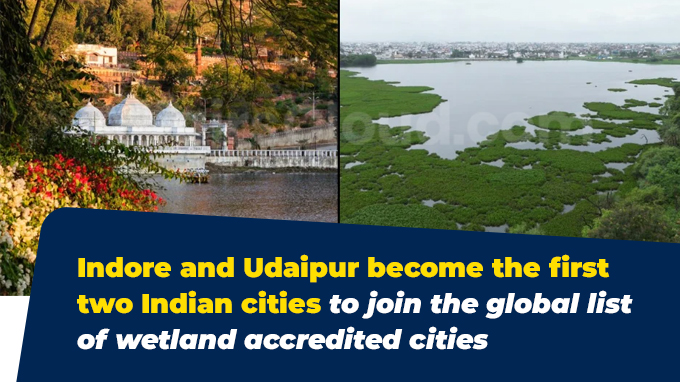 In January 2025, an independent Advisory Committee on Wetland City Accreditation(WCA) of the Ramsar Convention, announced the list of 31 newly accredited Wetland Cities, during its 64th meeting held in Gland, Switzerland. Among the newly accredited cities, Indore (Madhya Pradesh, MP) and Udaipur (Rajasthan) became the first two Indian cities to receive the international accreditation as ‘Wetland Cities’.
In January 2025, an independent Advisory Committee on Wetland City Accreditation(WCA) of the Ramsar Convention, announced the list of 31 newly accredited Wetland Cities, during its 64th meeting held in Gland, Switzerland. Among the newly accredited cities, Indore (Madhya Pradesh, MP) and Udaipur (Rajasthan) became the first two Indian cities to receive the international accreditation as ‘Wetland Cities’.
- With this, the total number of accredited Wetland Cities has reached 74.
- This accreditation was granted by the United Nations Educational, Scientific and Cultural Organization(UNESCO) under the Ramsar Convention. It is valid for 6 years to promotes the conservation and sustainable use of urban wetlands, ensuring ecological and socio-economic benefits for local populations.
Background:
In December 2024, the Ministry of Environment, Forests, and Climate Change (MoEF&CC) , Government of India (GoI), nominated three Indian cities: Indore, Udaipur, and Bhopal (MP).
- Indore: It is the cleanest city in India and the recipient of India’s Smart City Award 2023 for its best sanitation, water and urban environment. Sirpur Lake, a Ramsar Site in the city, has been recognised as an important site for water bird congregation and is being developed as a Bird Sanctuary.
- Udaipur: It is known as the City of Lakes, is surrounded by five significant wetlands: Pichola, Fateh Sagar, Rang Sagar, Swaroop Sagar, and Doodh Talai, which are vital to its ecological balance.
- Bhopal: One of the cleanest cities in India that has proposed conservation zones around the wetlands in its draft City Development Plan 2031. Bhoj Wetland, Ramsar Site is Bhopal’s lifeline, equipped with the world-class wetlands interpretation centre, Jal Tarang.
About Wetland City Accreditation(WCA):
i.The WCA is a voluntary accreditation system established by the Ramsar Convention during the Conference of the Contracting Parties (COP) 12 in 2015 to recognize cities that have taken exceptional steps to safeguard their urban wetlands.
ii.The WCA awarded to cities that demonstrate a commitment to conserving and sustainably managing their wetlands.
- To qualify, cities must meet six international criteria, which include measures to protect wetland ecosystems and promote their sustainable use.
iii.China leads the global Wetland City list with 22 cities, followed by France with 9 cities.
About Ramsar Convention:
The Ramsar Convention is an international treaty aimed at protecting and conserving wetlands and their resources. It was signed in 1971 in Ramsar, a city in Iran, and came into effect in 1975.
i.This treaty is unique as it is the only international agreement focused on a single ecosystem. It has 172 member countries, including India.
ii.India joined the Ramsar Convention in 1982. As of January 2025, India has a total of 85 wetlands protected under this treaty.
Points to Note:
- The Amrit Dharohar Initiative launched by MoEF&CC to promote unique conservation values of the Ramsar Sites in India.
- Tamil Nadu(TN) has the highest number of Ramsar Sites in India with 18 Ramsar Sites.
- The World Wetlands Day(WWD) is annually observed across the globe on 2 February to raise awareness about the importance of wetlands for human prosperity and a healthy planet.
Recent Related News:
In December 2024, the United Nations Educational, Scientific and Cultural Organization(UNESCO) unveiled a comprehensive roadmap marking the 20th anniversary of the devastating 2004 Indian Ocean tsunami to make all coastal community tsunami ready by 2030. This initiative was announced during an international conference in Banda Aceh, Indonesia.
- Under the UNESCO Tsunami Ready Programme, over 30 countries have established critical early warning systems, with 26 Indian and 12 Indonesian coastal communities recognized as tsunami-ready. Globally, 700 million people reside in tsunami-prone areas, a figure projected to reach 1 billion by 2050.




